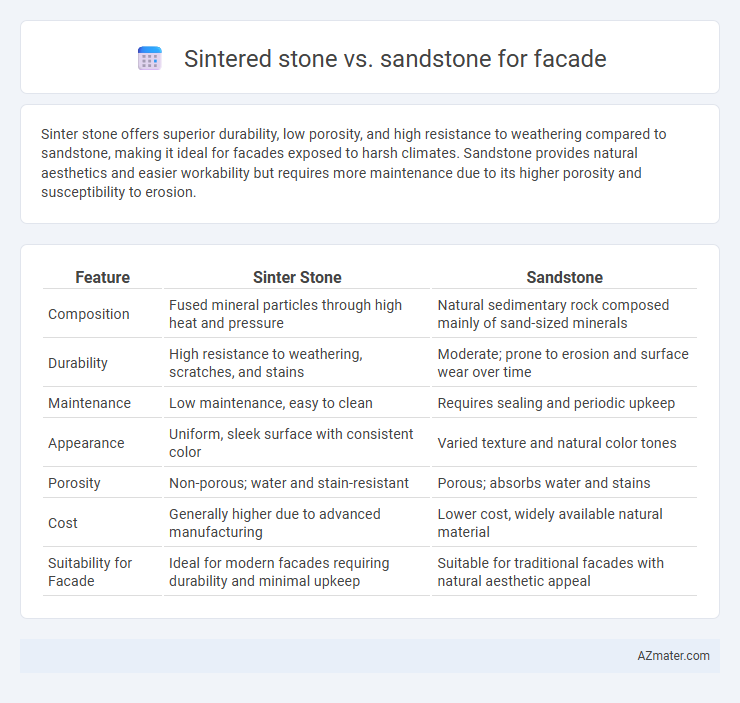Sinter stone offers superior durability, low porosity, and high resistance to weathering compared to sandstone, making it ideal for facades exposed to harsh climates. Sandstone provides natural aesthetics and easier workability but requires more maintenance due to its higher porosity and susceptibility to erosion.
Table of Comparison
| Feature | Sinter Stone | Sandstone |
|---|---|---|
| Composition | Fused mineral particles through high heat and pressure | Natural sedimentary rock composed mainly of sand-sized minerals |
| Durability | High resistance to weathering, scratches, and stains | Moderate; prone to erosion and surface wear over time |
| Maintenance | Low maintenance, easy to clean | Requires sealing and periodic upkeep |
| Appearance | Uniform, sleek surface with consistent color | Varied texture and natural color tones |
| Porosity | Non-porous; water and stain-resistant | Porous; absorbs water and stains |
| Cost | Generally higher due to advanced manufacturing | Lower cost, widely available natural material |
| Suitability for Facade | Ideal for modern facades requiring durability and minimal upkeep | Suitable for traditional facades with natural aesthetic appeal |
Introduction: Sinter Stone vs Sandstone for Facades
Sinter stone offers superior durability and low porosity compared to traditional sandstone, making it highly resistant to weathering and staining for facade applications. Sandstone, valued for its natural aesthetic and warm tones, requires regular sealing to maintain its appearance and structural integrity. Choosing between sinter stone and sandstone depends on factors like maintenance preferences, environmental exposure, and desired architectural style for the facade.
Material Composition and Properties
Sinter stone is a high-density, engineered material composed of finely crushed natural stone particles fused under extreme heat and pressure, resulting in superior strength, low porosity, and enhanced durability compared to traditional sandstone. Sandstone, a sedimentary rock primarily consisting of sand-sized mineral grains, typically quartz or feldspar, exhibits higher porosity and lower compressive strength, which can affect its weather resistance and longevity on facades. The dense, non-porous nature of sinter stone makes it more resistant to staining, frost damage, and erosion, making it a preferred choice for long-lasting, low-maintenance facade applications.
Aesthetic Versatility and Design Options
Sinter stone offers superior aesthetic versatility compared to traditional sandstone due to its ability to mimic a wide range of natural textures and colors while maintaining uniformity and durability. Its precision manufacturing allows for customizable sizes, shapes, and surface finishes, enabling architects to achieve intricate and modern facade designs that sandstone's natural variations may limit. Sandstone, favored for its organic and earthy appearance, provides authentic visual warmth but offers less flexibility in design due to its natural composition and susceptibility to weathering.
Durability and Weather Resistance
Sinter stone offers superior durability and weather resistance compared to traditional sandstone due to its denser composition and enhanced manufacturing process, which reduces porosity and increases resistance to moisture absorption and freeze-thaw cycles. Sandstone, while aesthetically appealing with its natural texture, tends to be more porous and susceptible to erosion, weathering, and staining over time, especially in harsh climates. For facade applications requiring long-term resilience against rain, wind, and temperature variations, sinter stone provides a more robust and low-maintenance solution.
Maintenance and Cleaning Requirements
Sinter stone offers superior resistance to stains, weathering, and dirt accumulation compared to sandstone, resulting in lower maintenance and less frequent cleaning requirements. Sandstone, being more porous and softer, demands regular sealing and careful cleaning to prevent erosion, discoloration, and moss buildup on facades. Choosing sinter stone enhances long-term facade durability while minimizing upkeep efforts in various environmental conditions.
Installation Process and Techniques
Sinter stone offers a precision-cut installation process due to its uniform thickness and smooth surface, allowing for seamless joints and minimal adhesive use compared to sandstone, which often requires irregular fitting and thicker mortar layers because of its natural texture and inconsistent slab sizes. The mechanical anchoring system commonly used for sinter stone ensures better structural stability and faster application, whereas sandstone typically relies on traditional mortar bedding and sometimes complicated anchoring due to its heavier weight and variable porosity. Proper substrate preparation is critical for both materials, but sinter stone's compatibility with modern fixing techniques reduces installation time and enhances overall facade durability.
Environmental Impact and Sustainability
Sinter stone offers enhanced durability and lower maintenance, reducing the long-term environmental footprint compared to sandstone, which may require frequent sealing and repairs. Sandstone is a natural, biodegradable material with excellent thermal insulation properties, but its extraction can cause significant ecological disruption and habitat loss. Choosing sinter stone with recycled content or sustainably sourced sandstone ensures a more eco-friendly facade option aligned with sustainable building practices.
Cost Comparison and Value
Sinter stone generally costs more than sandstone due to its advanced manufacturing process and enhanced durability, offering long-term value with lower maintenance expenses. Sandstone provides a more budget-friendly option initially but may incur higher upkeep costs over time because of its natural porosity and susceptibility to weathering. Choosing sinter stone for facades ensures greater longevity and cost-efficiency, while sandstone suits projects prioritizing upfront affordability.
Performance Over Time: Aging and Wear
Sinter stone exhibits exceptional durability and resistance to weathering, maintaining its structural integrity and appearance over decades with minimal fading or erosion. Sandstone, while aesthetically pleasing, tends to be more porous and susceptible to surface wear, discoloration, and biological growth such as moss or lichen as it ages. The compact, non-porous nature of sinter stone ensures superior long-term performance, reducing maintenance needs and preserving facade quality in harsh environmental conditions.
Best Applications and Recommendations
Sintered stone offers superior durability, low porosity, and resistance to weathering, making it ideal for modern facades exposed to harsh environmental conditions. Sandstone, with its natural texture and warm tones, is best suited for traditional or rustic facades where aesthetic appeal and historical character are priorities. For high-traffic urban developments or commercial buildings, sinter stone is recommended due to its minimal maintenance, while sandstone remains preferred for residential or heritage projects requiring natural beauty.

Infographic: Sinter stone vs Sandstone for Facade
 azmater.com
azmater.com